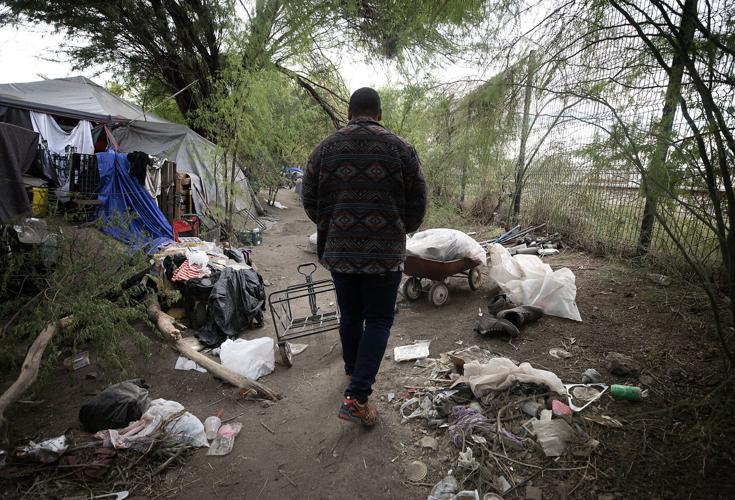Organizers of Pima County’s annual count of unhoused individuals are looking for volunteers to assist with interviews, support and more during Wednesday’s survey.
More than 300 volunteers are needed to help with the 2023 Everyone Counts! Point in Time Street Count on Jan. 25. No experience is needed but volunteers are required to watch a recorded training session and should be comfortable using an app on a smartphone.
The U.S. Department of Housing and Urban Development requires every municipality that receives federal funding for homeless assistance to take an annual count of people experiencing homelessness who are without shelter, as well as those staying in emergency shelters, transitional housing and safe havens on a single night.
Each count is carried out independently in communities across the nation. The counts help to inform a national understanding of homelessness but also help city and community groups provide services to people in need.
Officials say the count is especially important this year, as the pandemic made it impossible to collect accurate data during the past two years. It’s being conducted by the Tucson Pima Collaboration to End Homelessness and Tucson’s Housing and Community Development Department.
The count is also different this year in that it will involve an actual number as opposed to the estimation the federal government allowed participants to use last year, said city spokesman Andy Squire. The count was canceled in 2021.
“Based on that, it actually was likely higher than what we are going to see in this point-of-time count,” Squire said.
Last year’s estimate indicated 2,227 people were unsheltered or living in emergency shelters, transitional housing or safe havens. That number was up from 1,324 in 2020, when officials were last able to conduct a physical count, according to the Tucson Pima Collaboration to End Homelessness.
“The physical point-in-time count may not be more accurate, but it is the approved federal methodology that we have to use,” Squire said.
Squire said several factors have to be taken into consideration when looking at the results of the actual count, including that it’s extremely unlikely that canvassers will find every person in Pima County who is experiencing homelessness.
“The physical manifestation of houseless person activity we have in our community is hugely evident, and it’s far greater than it’s been in the past,” he said. “But there are places people are staying that we just don’t know about. Some people could be roaming about or not able to communicate for whatever reason, so we may not get an accurate image of if a person is really homeless.”
Checking places people seek shelter
During the count, teams of volunteers will visit camps in washes and the desert, bus stops, meal sites, abandoned buildings and other areas where people seek shelter. Volunteers will interview people to collect data.
Assisting with the count will be the city’s Housing First and Community Safety Health and Wellness teams, which recently moved into a new office space on Tucson’s south side.
The Community Safety Pilot Program was approved by the mayor and council in June 2020 and was charged with coordinating community safety efforts across city departments and with nonprofit partners. The program became permanent in 2021, with the city hosting forums and conducting surveys to expand community input.
Now, Community Safety Health and Wellness is an umbrella for several preexisting teams, including Housing First; the Tucson Police Department’s Homeless Outreach Team, Substance Use Resource Team and Mental Health Support Team; and the Tucson Collaborative Community Care program, made up of staffers from the Tucson Fire Department and Tucson Medical Center.
The program has also formed specialty teams related to care coordination, community outreach and “violence interruption”, a strategy that focuses on reducing homicides and shootings in communities by building relationships with people at the center of much gun violence.
The program now aims to provide nonenforcement responses to nonemergency 911 calls, often related to mental health, substance use or homelessness. It also coordinates with city departments and community partners to prevent crises related to the same factors.
New hub
El Pueblo Community Safety Hub is 23,000 square feet of office space formerly leased by the Arizona Department of Economic Security. The building sat vacant for years until the city was able to acquire and retrofit the building.
The 17 employees working in the building occupy one-third of the space, with plans in the works to bring in other community safety teams from the Tucson Fire Department and Tucson Medical Center.
The building is next to the Roy Laos Transit Center, which city officials say will be helpful when the teams begin to offer direct services to unsheltered people and others experiencing crises. For now, the hub is not open to the public but that will likely change.
Dozens of city and community safety employees turned out for an open house Tuesday night. Sarah Launius, Community Safety Health and Wellness director, said there had been “some stumbles and falls” during the team’s first few years, with many of the challenges they were tasked to address amplified by the pandemic.
“We are moving really, really quickly and growing and expanding and building upon some of our tried-and-true best practices in the city and trying to stretch as best we can to meet the really unique needs that we face right now,” she said.
Housing First Director Brandi Champion said she’s never encountered a local government that is so proactive and inclusive. “Leadership at the city really just puts their ideas out, listens to yours, we come up with a plan and then they get out of the way and let us do it,” Champion said.
“We’re really excited,” said Launius, “to use this as a space where we can bring thought partners together and try to do some thoughtful problem-solving that really is grounded in the needs of the folks we’re working alongside.”
About 30% of the people the Community Safety Health and Wellness team works with are experiencing homelessness, Launius said. The rest are experiencing other kinds of crises, although not always in the extreme sense.
“Crisis can happen often. We’re working to make sure people have the support network they need to stabilize,” she said. “The population we work with is folks who are in highly marginalized communities and who have complex social service needs.”
Her team focuses on ongoing engagement and helping individuals navigate available services, and outreach is also an important part of the job, Launius said.
“The idea is to meet people where they’re at and get them stable and help them sustain that,” she said.
Get a roundup of solutions reporting from the Arizona Daily Star at linktr.ee/starsolutions. Video by Caitlin Schmidt / Arizona Daily Star.
Arizona Daily Star reporter Caitlin Schmidt's top 5 stories of 2022
 |
We are sharing Arizona Daily Star reporters' and photographers' favorite work from 2022.
Caitlin Schmidt is the Star’s solutions reporter, covering people and places working to fix social problems and fill gaps in equity.
For Star subscribers: More than 600 people have graduated from Pima County's Drug Treatment Alternative to Prison and Drug Court programs, which focus on recovery and rehabilitation over punishment.
The Homing Project seeks to use micro-housing to help address the rising rate of homelessness across Pima County. But it needs land to make it happen.
The San Manuel Revitalization Coalition was established in 2020 after 200 community members came together to do something good for the place they call home.
Food bank officials are working with various organizations to bring native, food-producing shade trees to Tucson neighborhoods especially vulnerable to extreme heat.
Charles Collins has spent years developing and perfecting hydroponic and aquaponic gardening systems, which he says are a solution to address climate change.










